My BLW Baby at 12 Months Old: What Comes Next?
- When should my baby stop drinking milk out of a bottle?
- How much iron do 1 year olds need?
- How do I know if my baby/toddler is eating enough?
- Should I start giving snacks to a toddler if we didn't do snacks in infancy?
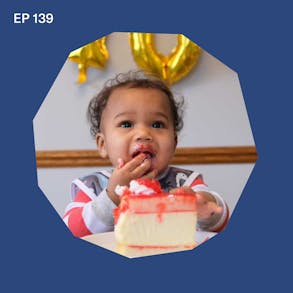
LISTEN TO THIS EPISODE
Episode Description
What nutrition and feeding changes happen when your baby turns 1 year old? What foods should a toddler eat that are different than in infancy? In this episode we’re looking at your 12 month old baby-led weaning baby, who is about to not be a baby anymore! This episode covers topics about monitoring growth in the 2nd year of life, how to wean your baby off the bottle, how calorie and nutrient needs change (slightly) and the 2 biggest things that sabotage the toddler’s diet: milk and snacks.
Links from this Episode
- Episode 113: Transitioning to Cow's Milk: How Do I Do This?
- Episode 35: Snacks: Why Early Eaters Don’t Need Snacks
- Baby-Led Weaning with Katie Ferraro program with the 100 First Foods™ Daily Meal Plan, join here: https://babyledweaning.co/program
- Baby-Led Weaning for Beginners free online workshop with 100 First Foods™ list to all attendees, register here: https://babyledweaning.co/baby-led-weaning-for-beginners

Latest Episodes
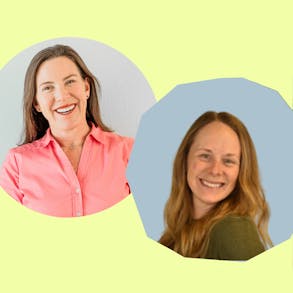
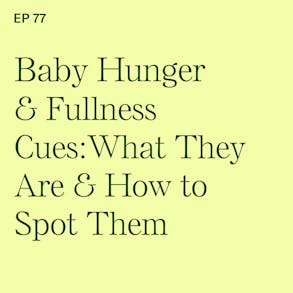
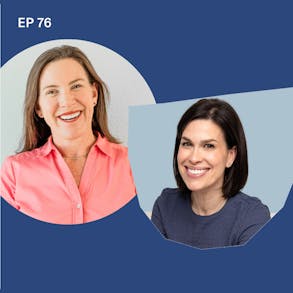
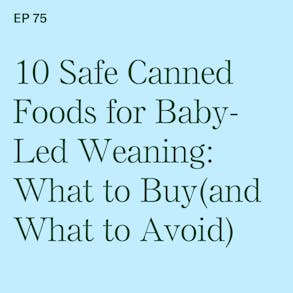
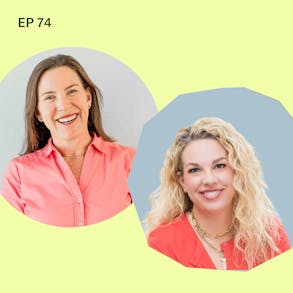
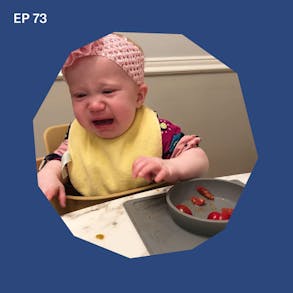
Katie Ferraro (0s):
And if you ask me, what are the two biggest factors that sabotage toddler intake at meal times milk and snacks, hands down. Too much milk or milk too close to mealtime and babies don't need snacks. And guess what? It's totally okay to have a snack free household for your toddler to, Hey there I'm Katie Ferraro, registered dietitian college nutritional professor and mom of seven specializing in baby led weaning here on the baby led weaning made easy podcast. I help you strip out all of the noise and nonsense about feeding, leaving you with the competence and knowledge you need to give your baby a safe start to solid foods using baby led weaning.
Katie Ferraro (42s):
Well, Hey guys, welcome back. This episode is for those of you who have a baby approaching the 12 month mark, or if you're just looking down the road and you want to know some things to be on the lookout for this episode is all about your BLW baby at 12 months of age, what comes next? So let's go ahead and start with some terminology difference between baby and toddler. I know that baby is always going to be your baby, but when we talk about babies, we're generally talking about up until the 12 month mark, right? Infancy technically expires at 12 months of age and then your baby becomes a toddler. So we're technically talking about that transition from infancy to toddler-hood and what are the things we want to be on the lookout for just aware of as our babies approach that one year mark to something, you know, magically change on their birthday, not technically, but from a nutrition standpoint, there is a whole new set of guidelines and recommendations for when your baby moves into toddlerhood.
Katie Ferraro (1m 38s):
So I'll go through them really briefly. We don't spend a lot of time focusing on the numbers here on the podcast, because that's not important. What is important is that our babies are learning how to become independent eaters, but I know some of you are the planning type and you like to know the numbers. So we'll go through them briefly as well with regards to nutrition needs. So when we're talking about how to gauge and monitor, whether we're doing a good job as parents with regards to offering our babies and toddlers nutrition, how do we know for doing a good job? We keep an eye on the growth chart, right? So for growth charts, your baby will continue to be measured on the birth to 36 month charts. If you're in the United States, that's the CDC charts, the same ones you've been tracking since birth. So at that 12 month appointment, you're going to have your baby measure weight for length, head circumference for age length, for age, weight, for age.
Katie Ferraro (2m 24s):
And those give indications of if your baby is tracking on the growth curve. So just keep an eye on that. Your baby should be staying on that growth path if they fall off, keep in mind that a lot of times that may be due to error in measurement techniques, because up until your baby turns three years old will actually still be obtaining your baby's length, lying down. But remember, there's a lot of inherent errors in that if the baby, you know, jerks or moves around or they Mismeasure by an inch or two, it actually makes a really big deal in the baby's measurements. So again, just keep an eye on those actual numbers. Let's talk about calories. Now, you guys know, I don't love counting calories. Sometimes parents are like, just give me a ballpark about how many calories does a one-year-old eat.
Katie Ferraro (3m 4s):
The general rule of thumb is for kids. One to three years old, we take the number 102 and multiply that time to the baby's weight in kilograms. So that will result in your baby's daily calories, which for most babies works out to be somewhere around, around a thousand calories. Now, the point is by the time your baby turns, 12 months of age, what are our goals we've been working through baby led weaning to achieve the goals at 12 months with just to back up and review is that we want babies to be seated at the table with the rest of the family, eating three meals a day. If that's what the family does and enjoying modified versions of the same foods that the rest of the family eats. So if your baby's not there yet, and you're not 12 months, that's fine. If you just keep it in mind as you approach that.
Katie Ferraro (3m 45s):
And if your baby turned 12 months of age and you're not there yet, it's not the end of the world, but something to think about, okay, what kind of tweaks or changes to the schedule or our feeding processes? Can I make to make that a reality? So again, don't stress about calories, but it should be somewhere around a thousand calories and something that does really change as we approach the one-year mark, is that we expect one year babies or toddlers. I'm just going to say one-year-olds because I always want to call them babies. That they're technically toddlers. We expect one-year-olds to be getting the majority of their nutrition from food and no longer from breast milk or formula. So all the other content in this podcast, when we're talking about six to 12 month old babies, especially early on in feeding, I always say, oh, breast milk or formula is the baby's primary source of nutrition that does change around the 12 month mark.
Katie Ferraro (4m 27s):
Now it's not overnight. We don't flip a switch, but you're working your way there. Especially in 10, 11 and 12 months of age, you're you really should be seeing an uptick in the percentage of the baby's nutrition, IE calories, and nutrients that the baby is getting from food and not from milk. And so we've got to keep an eye on the milk and be appropriately tapering the milk down. So let's talk about milk because that's another area that we're in, interested in as the baby transitions to 12 months of age, because of course the baby's going to transition from milk or formula to cow's milk. If you're breastfeeding, you're welcome to continue breastfeeding beyond one, or as long as you and baby are both comfortable. Well doing that. And if you're buying formula, I know you sure as heck, want to stop buying formula, and you can do that around at the one-year mark guest episode.
Katie Ferraro (5m 12s):
That's all about how to make the transition to cow's milk. If you guys want to check that out, it's episode one 13, transitioning to cows milk, how do I do this? Lots of tips for you in there on the actual, like logistics of making that I move to cow's milk. And let's talk about the amount of cow's milk. Cause one of the biggest problem areas that I see in toddler nutrition is children drinking too much milk. And parents are like, what? Milk is a good thing. Can't put too much of a good thing is not a good thing. Keep the milk in there. 16 to 24 ounce range when you get to 12 months of age and you should be nearing that with formula or breast milk, as you approach that for 11 months. And we like to see you kind of starting to mimic what you think will be happening when you make that change. Your baby might be getting a little bit more formula than that, but if you you're doing like 48 ounces of formula at 11 months, you're far away from that upper limit of 24 ounces of cow's milk.
Katie Ferraro (6m 0s):
So again, at 16 to 24 ounces of cow's milk at the 12 month mark, I personally find in my experience with my own seven children, as well as the numerous families that I've worked with for baby led weaning that 16 to 20 ounces is a tighter, better range for one-year-olds for milk, and certainly many families and many children thrive and do well with significantly less cows milk. What you don't want to do is be above 24 ounces. And that happens all the time. One-year-olds walking around with sippy cups, full of milk. They're full of milk, which by the way, has no iron in it. It makes them feel full. They then don't eat foods. And then all of a sudden they're just getting all the nutrition from milk, which is not adequate for a one-year-old. So just keep an eye on milk, 16 to 24 ounces.
Katie Ferraro (6m 40s):
When you switch to cow's milk. Now, parents always want to know when can I ease up on the sodium stuff, the sodium and the sugar stuff. Let's start with sugars because that's easiest. The American academy of pediatrics reminds us that no added sugars should be in the foods or drinks given to any child zero to two years of age. So you still need to avoid added sugars. First birthday's coming up. You might be having a party. There might be. Cake is at the end of the world. If the baby eats the birthday cake, heck now if your family's birthday cake at birthday parties, I'm a huge advocate of let your baby have some birthday cake, but should added sugars and desserts be part of every day. Feeding routines, absolutely not keep an eye on those food labels be vigilant because so many of the foods marketed directly to you right now have added sugars in them.
Katie Ferraro (7m 23s):
They're marketed to your kids through you is what I should say, but they do have added sugars in them. And we do want to avoid that. Now sodium, a lot of times, by the time the baby hits one year of age, even 100 different foods, they've had all these different tastes and textures. You're feeling adventurous. You're at restaurants. Yeah. You probably can loosen up, not being super strict about the sodium. But what I'd like to caution you about is really avoiding those typical traditional quote unquote kids' foods or kids' menu foods. You look at it, kid's menu and it's full of foods that babies and children shouldn't be eating lots of chicken nuggets and French fries in white pasta and no vegetables and refined carbohydrates and tons of added sodium. So unfortunately, sometimes see parents, they do a great job with a hundred first foods and they really push their baby's palate up to 12 months of age.
Katie Ferraro (8m 6s):
And they kind of like shake their hands and they're like, I'm done. You're a toddler. Now go ahead and eat off the kid's menu or dyno shaped chicken nuggets every night. And if you rely on those convenience foods on occasion, that's fine. But please remember that your baby and your toddler can become conditioned to expect those soft carbohydrate, those high fat, those high sodium processed foods. And then they're really not going to want to eat the variety of different foods that you want them to. So there's no obligation for you to feed your kid off the kid's menu. As your toddler gets older. If you eat at restaurants, one thing, I always challenge my kids too. They are welcome to eat anything they want in order anything they want off of the adults menu. They have a kid's menu. I just asked the server don't even bring it to the table because you've been doing this with your baby.
Katie Ferraro (8m 46s):
Your baby can eat modified versions of the same foods you eat. Guess what? Your bigger kids can do it as well. A few other things to be aware of as we shuffle your baby off into toddlerhood. I would say the two biggest things that sabotage toddler nutrition in my experience as a registered dietician and a mom of seven are snacks and milk. I already mentioned milk, but too often, toddlers are drinking too much milk or too big of servings of milk or milk out of a sippy cup or milk to close at to mealtime. Our goal with drinking is we want your baby to be able to drink out of an open cup on assisted. I'll be it with a little bit of spillage by the time the baby turns one. So lots of you are practicing with open cup, but if you haven't started practicing and your baby's not one yet, please start practicing today. Five minutes after each meal, we want your baby to go right from the breast or bottle directly to the open cup.
Katie Ferraro (9m 33s):
We do not need to drink sippy cups, and we don't want your babies to drink out of sippy cups. If this is news to you, go check out episode number 40, which is all about six reasons to skip the sippy cup with Dawn Winkelman. She's a speech language pathologist, good friend of mine, and also the creator of a number of different award-winning baby led weaning open cups. And she'll teach you all about the drawbacks to sippy cups. So skip the sippy cups. But what about the bottle? We want your baby to be off the bottle somewhere around the 12 month mark. It depends what resource you're looking at. I personally got a lot of things going on when the baby 12 months, right? We got to move to cow's milk. I'm trying to stop buying formula. We're probably switching our sleep schedule. I've got a birthday party to play it. I give myself a grace period somewhere when the 12 to 15 month period is when I try to get my babies off of the bottle entirely.
Katie Ferraro (10m 20s):
So that we're totally done with the bottle by 15 months of age. But I routinely see families who were our 18 month, 24 month olds drinking out of the bottle. You guys that's developmentally inappropriate. It's inappropriate. From a nutrition standpoint, it has the potential to delay their speech. Milestones got to focus on getting her baby off the bottle. And I'll be honest. Most of your pediatricians are not going to be asking you those questions at the 12 month appointment by 12 months of age, make sure your baby has been screened for anemia in the pediatrician's office. If you are in the United States of America, that is the American academy of pediatrics guidance on screening for anemia. If your baby has not had their hemoglobin checked, or unfortunately in some offices, they still send out for a full on blood panel, but usually in your office, they can do a finger stick or a heel stick test your baby's hemoglobin.
Katie Ferraro (11m 4s):
You want to know what your baby's iron status is because don't give up on iron. It is the most common micronutrient deficiency worldwide. It's a huge problem for toddlers. And we focus so much on iron because, oh my gosh, at six months, my baby's starting to lose the and stores that he got at the tail end of pregnancy. But then like by one parents like stopped caring about iron and it's a huge issue. Your toddler's brain is still developing that iron is still so important for their cognitive development. So don't give up on reading our labels and offering high iron foods. I mentioned milk and I mentioned snacks. Please do not be scared to be strict about snacks. I have a very strict, no snacks policy in my house for all children. We just don't eat snacks.
Katie Ferraro (11m 45s):
I have control over our feeding schedule and what time we eat meals. My kids are allowed to have a cup of milk in between meals, but if the we're going to be on our feeding schedule, they don't need, I know that doesn't work for every family, but I want you to know that you are still the boss of the snack schedule in your house. Do not let snacks dominate your life. People are like, why don't you work with toddlers? I was like, because it's all the same stuff. Parents being like, oh my to-do don't eat the food that I make. If your child is not experiencing any hunger at mealtime, guess what? They're not going to eat the food that you're making for them. And why are they not experiencing hunger at mealtime? Because they're stuffed full of snacks at daycare or wherever they're going, or they're begging you for snacks all day. You've got to find ways to manage that within your own household, but it is perfectly acceptable for toddlers to not have snacks.
Katie Ferraro (12m 27s):
And any time you hear other self-proclaimed FIDI experts saying toddlers need three meals and two to three snacks a day that is asinine. It is completely made up. There is no research to suggest that you are more than welcome to make a feeding schedule that does not include snacks for your toddler. You can ask max, if you want to, but you are ultimately the boss don't let the toddler be the boss of the snack schedule regarding picky eating. Please know that some degree of picky eating will set in in the second year of life. When your baby turns one, there's some degree of picky eating, but the whole point of doing baby led weaning, especially if you've been doing my hundred first foods approach is that if your baby has a hundred foods under their belt, when you approach the one-year mark and you lose 10 or 15 of those foods to picky eating no big deal, right?
Katie Ferraro (13m 9s):
You still got 85 or 90 foods that your toddler will eat. But if you are like a traditional spoonfed baby who, when they turn one, they have only eaten 10 or 15 different foods. And then you lose those 10 or 15 foods to picky eating. Oh my gosh, that becomes an extremely challenging toddler to feed. So continue to offer a variety of foods. Even once you kind of like I'm confident my baby can eat these foods. Don't give up on the variety and keep the variety up. As you move into, toddlerhood continue to offer new foods, continue to offer a variety of foods, continue to re-introduce previous foods, keeping in mind that babies may need to see a food 10 to 15 times before they like or accept it. If you haven't grabbed my hundred first foods list, that's available to everyone on my free baby led weaning for beginners workshop.
Katie Ferraro (13m 55s):
This is a workshop. That's all about how to help your baby eat a hundred different foods before your baby turns one, without you having to spoonfeed, purees or buy pouches, you can get signed up for the workshop times for this week on the show notes. For this episode, if you go to BLW podcast.com forward slash 1, 3 9, I'm also going to link a few other episodes that I think you might be interested in. As you transition to this, one-year mark with your one-year-old and you know, have a little celebration for yourself as well. I see so many of you celebrating your babies, hitting the a hundred first foods, mark. It usually is around the time they're 11 or 12 months of age, but don't forget to take a second to congratulate yourself because by offering your baby a variety of different foods, like a hundred different foods, you really are laying the groundwork for your child to have a healthy relationship with food.
Katie Ferraro (14m 43s):
And that's because you're promoting their ability to become an independent eater and you're working to prevent picky eating. So congratulations on making it to the 12 month. Mark. I hope you have a party to celebrate. I hope there's real cake there. If you're a real cake eater, people messaged me like, can I have your recipe for a sugar-free vegan gluten-free smash cake? And I'm like, no, because I don't have one because in our family we eat real cake. So I know some of you guys make like crazy healthy cakes for your first birthday, if that's your thing, go for it. But remember the whole point of baby led weaning is to allow our babies to participate in family meals from their first bites. And that's certainly the goal by the 12 month mark. And congratulations when you get there, because again, you have laid this amazing foundation for your child to have a healthy relationship with food moving forward.
Katie Ferraro (15m 31s):
So congrats and good luck feeding your toddler as well.
2 (15m 35s):
Bye now,
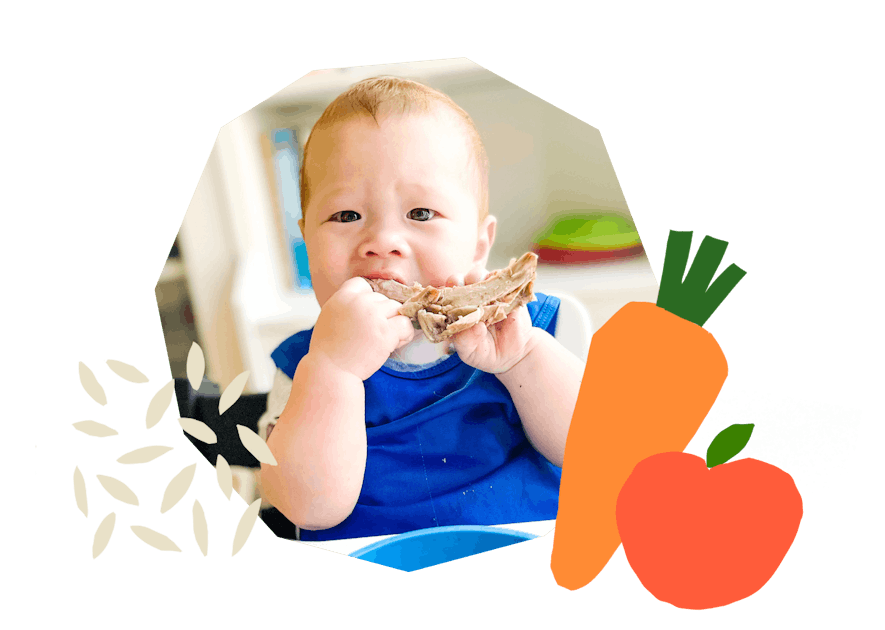
The Program Baby-Led Weaning with Katie Ferraro
A step-by-step digital program for starting solid foods safely and navigating the original 100 FIRST FOODS™ meal plan with baby-led weaning.
 EXPERT-LED, PROVEN APPROACH TO EATING REAL FOOD
EXPERT-LED, PROVEN APPROACH TO EATING REAL FOOD CONCISE VIDEO TRAININGS TO MASTER BABY-LED WEANING
CONCISE VIDEO TRAININGS TO MASTER BABY-LED WEANING 100 FIRST FOODS DAILY MEAL PLAN WITH FOOD PREP VIDEOS
100 FIRST FOODS DAILY MEAL PLAN WITH FOOD PREP VIDEOS
Baby-Led Weaning for Beginners Free Workshop
Is your baby ready to start solid foods, but you’re not sure where to start? Get ready to give your baby a solid foundation to a lifetime of loving real food…even if you’re feeling overwhelmed or confused about this next stage of infant feeding.
Get baby-led weaning recipes and tips delivered to your email inbox.

